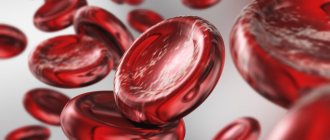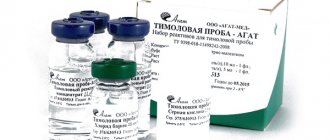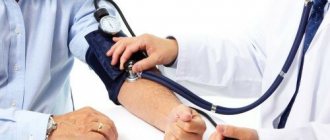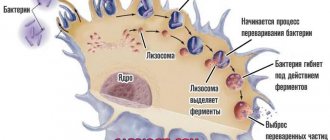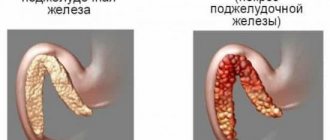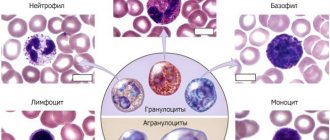What is the normal hemoglobin level in women?
Hemoglobin content is determined by a general blood test. Its normal value in women varies from 120 to 140 g/l. A higher rate may be observed in professional athletes (up to 160 g/l) or in women who smoke (up to 150 g/l). In such cases, a slight deviation is considered as a variant of the norm.
Doctors use a separate scale to assess the level of hemoglobin in the blood of pregnant women. The lower limit of normal in the first and third trimester of pregnancy is considered to be 110 g/l, in the second - 105 g/l. The upper value during the entire period of waiting for the child should not exceed 120 g/l.
The significant difference in normal values between pregnant and non-pregnant women is explained by physiological changes occurring in the body of the expectant mother. During gestation, the volume of circulating blood increases by 50%, so it becomes increasingly difficult for the bone marrow to supply sufficient hemoglobin. In addition, additional iron consumption is required for the formation of the placenta and the growing embryo.
| Group | Hemoglobin norm |
| Average level for all women | from 120 to 140 g/l |
| Smoking women | up to 150 g/l |
| Women doing sports | up to 160 g/l |
| Pregnant women in the 1st and 3rd trimester | 110 g/l |
| Pregnant women in the second trimester | 105 g/l |
Treatment and medications for low hemoglobin
Of course, treatment of anemia always includes the prescription of medications. It is impossible to eliminate iron deficiency anemia without iron supplements, only with a diet that includes a lot of iron. The absorption of iron from food is limited, its maximum is 2.5 mg/day. From medicinal preparations, iron is absorbed 15-20 times more.
However, the food must be complete and contain a sufficient amount of well-absorbed iron and protein. It is better to take iron supplements together with ascorbic acid. The latter improves the absorption of iron in the intestines. Since food significantly reduces the absorption of inorganic iron, taking the tablets before meals is more effective.
There are a wide variety of iron supplements. Experience has shown that organic salts of ferric iron and iron compounds with various organic radicals are most easily absorbed by the body and do not cause side effects. Such drugs are safer, they have less risk of overdose and poisoning than coarser inorganic salts. The gums and teeth do not darken, there is no heaviness in the stomach, and quite rarely there is a need to discontinue the drug.
Iron supplements
Now there are many medicines on the market that can be taken orally: coated tablets, for example Sorbifer Durules, chewable tablets Maltofer and Ferrum Lek, Actiferrin drops, Ferrum Lek and Actiferrin syrups for children, Actiferrin and Maltofer drops for infants, there are also injectable forms : Ferrum Lek, at the moment they are used strictly under the control of blood tests.
During pregnancy, it is especially necessary to carefully monitor the hemoglobin level in the blood. For pregnant and lactating women, there are special forms: chewable tablets Maltofer Fol, long-acting tablets coated with Tardiferon, which contain not only iron salts, but also folic acid, which is necessary during pregnancy in higher doses. Depending on the age of the child, a drop form or syrup (Aktiferrin, Maltofer, Ferrum lek) is selected and treatment is carried out.
Increased hemoglobin in women
The reasons for increased hemoglobin in women can be both physiological and pathological. The first include intense physical activity and prolonged exposure to hypoxic conditions (for example, living in a high mountain region). At the same time, the body begins to experience an acute lack of oxygen, which is compensated by the “overproduction” of red blood cells. Such deviations from the norm, as a rule, are always insignificant - within 10-20 g/l. They do not alarm doctors and do not require medical intervention.
The situation is much more serious if hemoglobin increases without obvious reasons. This may be a sign of dangerous pathologies, in particular heart disease, diabetes mellitus, intestinal obstruction or cardiopulmonary failure.
It is most dangerous when the hemoglobin concentration reaches 180-190 g/l. At the same time, there is an increase in blood viscosity, microcirculation processes are disrupted, and oxygen delivery to organs becomes difficult. Such patients are diagnosed with blueness of the tips of the fingers and toes, rapid fatigue, decreased appetite, absent-mindedness and irritability.
Long-term circulatory disorders lead to the development of thromboembolism (blockage of blood vessels). Therefore, excessively high hemoglobin levels are a condition that requires immediate treatment.
How to reduce hemoglobin in women?
The following measures can be used to reduce hemoglobin:
- Diet therapy. The patient is asked not to abuse foods high in iron: red meat, animal by-products (liver, kidneys, etc.). The consumption of foods that increase cholesterol levels and blood viscosity (butter, pork, caviar, confectionery) is limited. It is recommended to fill the diet with protein foods: legumes, white meat, fish. Fast food, carbonated drinks, canned food and semi-finished products are completely excluded. Also, during the treatment period, it is prohibited to take vitamin-mineral complexes containing vit. B12, folic acid and iron.
- taking antiplatelet agents. Such drugs thin the blood and reduce the risk of blood clots. However, you should not use them yourself without the appointment of a specialist - you can harm your health. You should consult your doctor about the rationale for using antiplatelet drugs.
- Search for the underlying disease. An increase in hemoglobin levels indicates a malfunction in the body. To identify the cause of the problem, the doctor must prescribe a comprehensive medical examination.
Low hemoglobin in women
A condition in which hemoglobin falls below normal is called iron deficiency anemia (or anemia). An experienced doctor is able to detect pathology even before undergoing laboratory tests, barely looking at the patient who contacts him. A pale face, dry skin, pockets in the corners of the mouth, dull hair and sluggish movements are the main symptoms of low hemoglobin. And if, in addition to this, a woman complains of increased fatigue, “spots” in the eyes and frequent dizziness, then the diagnosis is not at all in doubt.
In pregnant women, anemia is often accompanied by eating and smell disorders. The desire to eat chalk, coal, sand, smell whitewash or gasoline is by no means a “cute whim” of the expectant mother, but a reason to see a doctor.
The danger of anemia lies in the insufficient supply of oxygen to the tissues. At the initial stages of the disease, the body tries to cope with the lack of a vital element, depriving it of the least significant organs from its point of view (hair, nails, teeth). However, over time, oxygen deficiency increases and everyone has to “starve”, including the brain and heart. In order to prevent serious complications, it is important to identify and eliminate the cause of the disease at an early stage of its development.
Causes of low hemoglobin in women
Anemia can be caused by:
- Poor nutrition. In order for hemoglobin to be synthesized in the required quantity, a sufficient amount of iron must be supplied to the woman’s body with food. Its main source is animal products: meat, liver, kidneys. Plants also contain iron, but in a form that is much less easily absorbed. This is why vegetarianism and low-meat diets are becoming one of the most common causes of anemia. A decrease in hemoglobin can also be caused by excessive consumption of foods that inhibit iron absorption: coffee, tea, chocolate, cereals.
- Lack of folic acid, vit. C or Vit. B12 in the body. All these elements play an important role in the formation of hemoglobin. Vitamin deficiency B12 is most often caused by helminthic infestation, and a lack of vit. C and folic acid - an unbalanced nutritional diet.
- Blood loss. They can be both obvious (with systematic donation, heavy long menstruation, uterine bleeding) and hidden (blood loss associated with hemorrhoids, ulcerative lesions of the digestive tract, polyps in the large intestine, etc.).
- Hypothyroidism. The thyroid hormone, thyroxine, regulates the absorption of iron in the intestines. Its deficiency also entails a lack of hemoglobin.
- Diseases of the digestive system. Gastritis, ulcerative lesions of the stomach or intestines lead to thinning of the mucous membrane of the digestive tract, as a result of which iron practically ceases to be absorbed.
- Premature death of red blood cells. This condition can be caused by long-term infectious diseases (hepatitis, tuberculosis, etc.) or immune disorders (for example, lupus erythematosus, rheumatoid arthritis).
- Sedentary lifestyle. Physical activity is one of the factors influencing the synthesis of red blood cells. If the blood is not rapidly dispersed throughout the body, the brain receives signals that there are “enough” red blood cells and their additional synthesis is not required.
- Stress. They can cause a decrease in appetite and, as a result, insufficient intake of iron from food.
On topic: 5 superfoods to quickly increase hemoglobin!
Iron deficiency anemia: causes, prevention and treatment
Chronic fatigue, pale skin and dizziness can be associated with overwork.
However, symptoms that seem harmless at first glance may turn out to be a signal of serious problems in the body. According to the World Health Organization, about 20% of women worldwide suffer from iron deficiency anemia (hereinafter referred to as IDA). It is important to know that latent (hidden) iron deficiency is widespread among the population, the frequency of which ranges from 20 to 30%. The daily iron requirement for men is 10 mg, for women – 15 mg (20–25 mg for pregnant and lactating women), and for children – 5-15 mg, depending on age.
Iron deficiency anemia is indicated by a low hemoglobin level, but a latent state is when the hemoglobin level is still normal, but the body’s iron reserves are already depleted.
There are three stages of iron deficiency in the body:
1. Prelatent iron deficiency is a hidden iron deficiency when the body accumulates iron with the help of ferritin, an iron-containing protein. If the ferritin level in the biochemical blood test is low, this indicates pre-latent iron deficiency.
2. Latent iron deficiency - at this stage, along with ferritin, tissue reserves of iron are depleted with optimal hemoglobin levels, clinical symptoms of iron deficiency are not observed, a compensatory increase in iron absorption occurs in the intestine, and the activity of iron-containing enzymes gradually decreases.
3. Obvious iron deficiency is characterized by a decrease in the number of red blood cells and a decrease in the level of hemoglobin, which is part of red blood cells and is a substance that transports oxygen to the body tissues from the lungs, the development of dystrophic changes in organs and tissues, as well as an increased amount of protoporphyrin in red blood cells.
Redox processes and the supply of oxygen to cells depend on the concentration of iron in the blood. Despite the fact that people of different sexes and ages can encounter the problem of iron deficiency anemia, anemia is considered a “female” pathology, more precisely a disease of women aged 15–45 years. About 50 to 86% of women in various populations have risk factors for anemia. The reason for this is pathological menstruation (long or heavy), pregnancy and lactation. During pregnancy, iron consumption increases sharply for the needs of the fetus and placenta, blood loss during childbirth and lactation. The iron balance during this period is on the verge of deficiency, and various factors that reduce iron intake or increase iron consumption can lead to the development of IDA.
Causes of anemia
IDA often develops with gastrointestinal (hemorrhoids, peptic ulcer) and uterine (uterine fibroids) bleeding or is associated with chronic diseases: inflammation of the pancreas or duodenum, bronchitis, kidney disease. Impaired absorption of this microelement is another reason why it is not used by the body for its intended purpose. In this case, the problem can be provoked, for example, by chronic gastritis.
Plant-based or fermented milk diets also contribute to the development of anemia. The fact is that iron is better absorbed from foods of animal origin - meat, fish, seafood, and dairy foods are rich in calcium, which interferes with the absorption of iron.
Dry skin, cracks in the corners of the mouth (angular stomatitis), brittle hair and nails, shortness of breath, dizziness, decreased performance, as well as the desire to taste chalk and deeply inhale the smell of fresh paint or gasoline are symptoms indicating a lack of iron in the body. However, these symptoms are not enough to make a diagnosis. To confirm IDA, you need to take general and biochemical blood tests. Hemoglobin is responsible for the circulation of oxygen in the blood. In case of iron deficiency, its level is usually reduced - less than 115–120 g/l (in women). However, in the early stages of the disease, hemoglobin may be normal. Laboratory determination of the level of serum iron, as well as transferrin and ferritin - proteins responsible for transporting iron to organs and tissues and creating a reserve of the microelement in the body - allows you to avoid mistakes in making a diagnosis. These indicators are markers of anemia at the initial stage and their low level indicates a problem.
To find out the cause of the disease, you will need to undergo additional examination - first of all, check the functioning of the gastrointestinal tract (using gastroscopy, x-ray of the stomach, colonoscopy) and the organs of the reproductive system.
Experts agree: a balanced diet, including foods high in iron, is the best prevention of iron deficiency. Among the record holders for the amount of valuable microelements are meat (beef, lamb), fish and seafood, buckwheat, sesame seeds, pumpkin seeds and apples. It should be remembered that iron cannot be absorbed normally if there is a deficiency of vitamin C and folic acid. Iron absorption is also inhibited by polyphenols and phytates found in tea, coffee, whole grains and dairy products. It is also important to take into account the fact that the longer the product is subjected to heat treatment, the less iron remains in it. According to recent data, the bioavailability of iron from the normal adult diet is no more than 10%, and in developing countries this figure is below 5%.
Therefore, if iron deficiency anemia has already occurred, then it is impossible to cope with it with diet alone. To prevent IDA, doctors also recommend that women of fertile age not only eat right, but also take additional medications containing iron.
Treatment of iron deficiency anemia, although simple, is quite lengthy. The principle of treatment is extremely simple: eliminating the cause of iron deficiency and taking iron supplements. The main mistake encountered in practice is prescribing iron supplements for a short period of time. Even a slight iron deficiency can be replenished within at least two months. For severe iron deficiency, treatment may last six months or more. In the vast majority of cases, iron supplements are prescribed in the form of oral preparations (capsules or tablets).
Medicine FERROFOL in capsules
– a combined antianemic agent based on iron in combination with folic acid.
Ferrofol contains: elemental iron – 50.00 mg (in the form of iron II sulfate), folic acid – 0.50 mg.
Important advantages of Ferrofol:
- Available in the form of extended-release capsules
- The iron content in the preparation is in the daily preventive doses recommended by WHO
- the active ingredients are contained in pellets (microgranules), which ensure their absorption mainly in the upper part of the small intestine
- the absence of local irritation on the gastric mucosa contributes to good gastrointestinal tolerability of the drug
Who do we recommend and how to take Ferrofol?
Adults over 18 years of age take Ferrofol before or during meals. Capsules must be swallowed whole.
For mild iron deficiency anemia and hidden (latent) iron deficiency with folic acid deficiency or for the prevention of iron deficiency and folic acid deficiency: 1 capsule per day.
For severe iron and folic acid deficiency (not in pregnant women): 1 capsule 2-3 times a day.
During pregnancy for the prevention and elimination of iron deficiency and folic acid deficiency: maximum dose of 2 capsules per day.
Ferrofol is a ferrous iron preparation, has good bioavailability, and can significantly increase hemoglobin levels within 2–4 weeks after starting administration.
It must be remembered that many foods and medications (for example, antacids) impair iron absorption. Taking this into account, Ferrofol should be taken one hour before meals or two hours after meals. If you are taking other medications, the interval between them should be at least two hours before or four hours after taking them. Ferrofol should be taken with water, or with apple or orange juice.
The main side effects when taking iron supplements are related to the gastrointestinal tract: constipation, diarrhea, nausea, metallic taste in the mouth. If such side effects are observed while taking Ferrofol, you do not need to stop taking the medications, but should consult your doctor; you will probably be advised to reduce the dose of the drug for a single dose, which will avoid negative effects. It is important to know that iron supplements can turn stool black; this is not a sign of gastrointestinal bleeding, but a normal reaction of intestinal contents to interaction with iron.
Iron salts are taken under the supervision of a doctor. The dose and duration of treatment are individual and depend on the degree of iron and folic acid deficiency.
BEFORE USING THE MEDICINE, READ THE INSTRUCTIONS. There are medical contraindications and side effects.
26 Oct 2020
Previous News Feed Next
What to do if a woman’s hemoglobin is 60-80?
A hemoglobin level below 80 g/L is considered severe anemia. Correction of the condition is carried out taking into account the factor that caused it. To find out the cause of the pathology, the woman is asked to undergo a series of tests and see specialists: a gynecologist, a gastroenterologist, an endocrinologist, and a nutritionist. After identifying the underlying disease, the patient is selected a set of therapeutic measures aimed at combating it.
Proper nutrition is definitely recommended. A woman's daily diet should include foods rich in iron and vitamins.
These include:
- beef, lamb, white rabbit meat,
- liver, tongue, kidneys,
- egg yolk,
- dried apricots, raisins, prunes, figs,
- apple and pomegranate juice,
- buckwheat soups and porridges,
- legumes,
- sprouted grains of wheat,
- rosehip decoction,
- plums, green apples,
- almonds and walnuts.
The body itself is able to regulate the amount of iron absorbed from food - if there is a shortage, it increases and vice versa.
Drinking plenty of fluids is very useful for low hemoglobin. Doctors advise taking 1/4 cup of plain water and juices every 30 minutes.
On topic: List of foods to increase hemoglobin
